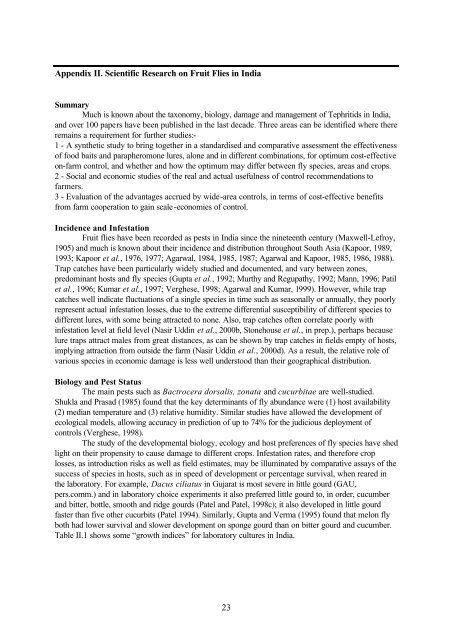“Key Informant Survey” of Production, Value, Losses and ... - DfID
“Key Informant Survey” of Production, Value, Losses and ... - DfID
“Key Informant Survey” of Production, Value, Losses and ... - DfID
You also want an ePaper? Increase the reach of your titles
YUMPU automatically turns print PDFs into web optimized ePapers that Google loves.
Appendix II. Scientific Research on Fruit Flies in India<br />
Summary<br />
Much is known about the taxonomy, biology, damage <strong>and</strong> management <strong>of</strong> Tephritids in India,<br />
<strong>and</strong> over 100 papers have been published in the last decade. Three areas can be identified where there<br />
remains a requirement for further studies:-<br />
1 - A synthetic study to bring together in a st<strong>and</strong>ardised <strong>and</strong> comparative assessment the effectiveness<br />
<strong>of</strong> food baits <strong>and</strong> parapheromone lures, alone <strong>and</strong> in different combinations, for optimum cost-effective<br />
on-farm control, <strong>and</strong> whether <strong>and</strong> how the optimum may differ between fly species, areas <strong>and</strong> crops.<br />
2 - Social <strong>and</strong> economic studies <strong>of</strong> the real <strong>and</strong> actual usefulness <strong>of</strong> control recommendations to<br />
farmers.<br />
3 - Evaluation <strong>of</strong> the advantages accrued by wide-area controls, in terms <strong>of</strong> cost-effective benefits<br />
from farm cooperation to gain scale-economies <strong>of</strong> control.<br />
Incidence <strong>and</strong> Infestation<br />
Fruit flies have been recorded as pests in India since the nineteenth century (Maxwell-Lefroy,<br />
1905) <strong>and</strong> much is known about their incidence <strong>and</strong> distribution throughout South Asia (Kapoor, 1989,<br />
1993; Kapoor et al., 1976, 1977; Agarwal, 1984, 1985, 1987; Agarwal <strong>and</strong> Kapoor, 1985, 1986, 1988).<br />
Trap catches have been particularly widely studied <strong>and</strong> documented, <strong>and</strong> vary between zones,<br />
predominant hosts <strong>and</strong> fly species (Gupta et al., 1992; Murthy <strong>and</strong> Regupathy, 1992; Mann, 1996; Patil<br />
et al., 1996; Kumar et al., 1997; Verghese, 1998; Agarwal <strong>and</strong> Kumar, 1999). However, while trap<br />
catches well indicate fluctuations <strong>of</strong> a single species in time such as seasonally or annually, they poorly<br />
represent actual infestation losses, due to the extreme differential susceptibility <strong>of</strong> different species to<br />
different lures, with some being attracted to none. Also, trap catches <strong>of</strong>ten correlate poorly with<br />
infestation level at field level (Nasir Uddin et al., 2000b, Stonehouse et al., in prep.), perhaps because<br />
lure traps attract males from great distances, as can be shown by trap catches in fields empty <strong>of</strong> hosts,<br />
implying attraction from outside the farm (Nasir Uddin et al., 2000d). As a result, the relative role <strong>of</strong><br />
various species in economic damage is less well understood than their geographical distribution.<br />
Biology <strong>and</strong> Pest Status<br />
The main pests such as Bactrocera dorsalis, zonata <strong>and</strong> cucurbitae are well-studied.<br />
Shukla <strong>and</strong> Prasad (1985) found that the key determinants <strong>of</strong> fly abundance were (1) host availability<br />
(2) median temperature <strong>and</strong> (3) relative humidity. Similar studies have allowed the development <strong>of</strong><br />
ecological models, allowing accuracy in prediction <strong>of</strong> up to 74% for the judicious deployment <strong>of</strong><br />
controls (Verghese, 1998).<br />
The study <strong>of</strong> the developmental biology, ecology <strong>and</strong> host preferences <strong>of</strong> fly species have shed<br />
light on their propensity to cause damage to different crops. Infestation rates, <strong>and</strong> therefore crop<br />
losses, as introduction risks as well as field estimates, may be illuminated by comparative assays <strong>of</strong> the<br />
success <strong>of</strong> species in hosts, such as in speed <strong>of</strong> development or percentage survival, when reared in<br />
the laboratory. For example, Dacus ciliatus in Gujarat is most severe in little gourd (GAU,<br />
pers.comm.) <strong>and</strong> in laboratory choice experiments it also preferred little gourd to, in order, cucumber<br />
<strong>and</strong> bitter, bottle, smooth <strong>and</strong> ridge gourds (Patel <strong>and</strong> Patel, 1998c); it also developed in little gourd<br />
faster than five other cucurbits (Patel 1994). Similarly, Gupta <strong>and</strong> Verma (1995) found that melon fly<br />
both had lower survival <strong>and</strong> slower development on sponge gourd than on bitter gourd <strong>and</strong> cucumber.<br />
Table II.1 shows some “growth indices” for laboratory cultures in India.<br />
23

















